J.M. Hurby
Anyone with even a casual interest in hunting and shooting sports already knows the AR has truly arrived as a sporting firearm. The AR platform used to be best known for its military cousin the M16, but in recent years this rifle design has become sporterized in the same way that great military designs such as the 98 Mauser and the 1906 Springfield were for past generations.
The AR is now everywhere, on rifle ranges, in competitions, and increasingly in the field as a hunting weapon. The best-known sporting configurations are the AR-15, which is most popular in the .223/5.56 chambering and the AR-10, which is upsized to handle larger calibers like the .308/7.62.
Unlike the Springfield and the Mauser, the AR is not a specific rifle or action. At its core the AR is really a design specification that hundreds of makers worldwide have used to produce rifles and components. The AR’s parts are (relatively) interchangeable and this interchangeability is certainly one of the many reasons for the AR’s surge in popularity.
Earlier this winter, I decided I was finished riding the pine. It was time for this rifleman to finally get into the AR game.
This won’t be your standard gun review. Instead, I’m going to combine my general thoughts on the AR platform with a review of the specific AR that I chose–the Mossberg MMR.
Decisions, Decisions, Decisions
My criteria for deciding on a first off-the-rack AR were simple. First, any smallbore rifle in my arsenal must pull its weight as a hunting rifle. In my case, a varmint and predator hunting rifle. This eliminated the carbines and other more recreational-shooter-focused short barrel combat style ARs.
I wanted at least MOA potential, hunting-specific features, low overall weight, and the velocity potential of a 20-inch barrel. For a first AR, I wasn’t interested in home “builds”, I wanted something off-the-rack with a proved reputation and a warranty. Finally, since I had no guarantees that this AR marriage wasn’t heading for a messy divorce, I limited my budget to less than $800.
I looked at variety of brands and models and the best fit for my needs and price range actually made the selection pretty narrow. The Mossberg MMR (Mossberg Modern Rifle) Hunter caught my attention because it engineered as a hunting-specific AR and came in a configuration closely matched for what I was looking for.
Mossberg is not a Johnny-come-lately to the AR game. Even though the MMR is their first consumer-focused AR lineup, they have been building AR components for years.
Let’s get the tech specs out of the way first. The Mossberg MMR is chambered in .223/5.56 and it has a 20-inch, free-floating, 1:9 twist barrel. The action is an autoloading, direct impingement gas system.
The overall length of the MMR Hunter with its fixed A2 stock is 39 inches. It is a flat top configuration, which means it is optics ready, but it has no sights. For optics mounting there is a Picatinny rail and it has 2 swivel studs on the fore-end for a bipod and sling and one sling attachment point on the stock.
The MMR Hunter comes in an all black version and two camo patterns, Mossy Oak Brush and Mossy Oak Tree Stand. The barrel has a black phosphate finish on all variations.
There are two notable features generally found on ARs, which Mossberg has chosen to omit on the MMR. There is no ejection port dust cover and no forward assist, a mechanism, which enables the operator to push the action into battery in the event that it does not fully engage when the bolt is closed. Whether or not you view the lack of these as good or bad depends mainly on personal preference.
I ordered my MMR Hunter in Mossy Oak Brush camo, which will make the rifle almost invisible in the areas where I hunt coyotes. The camo application seems to be durable and the finish is good.
The MMR came fully assembled, throw in ammo and fire away! The MMR sports a 10 round magazine with a laughably placed rivet to restrict the follower so it can actually only hold 5 rounds. Presumably this is to make the MMR out-of-box legal in more locales, but if no magazine restrictions are in place in your state, you could simply drill out the rivet and you’d have a 10 round magazine.
The optic I chose was Nikon’s P-223 with 3x12x42 with the BDC 600 reticle. This reticle combined with Nikon’s easily adjustable Rapid Action Turrets give the long-range shooter some interesting options for either holdover using the calibrated reticle or point-of-aim adjustments using the turrets. For mounting, I chose a Nikon M-223 single-piece mount, which unifies both the rings and the base into one unit for durability and stability.
With the scope mounted, my rifle weighs 8 pounds 9 ounces without a magazine or ammo.
The out-the-door price of my Mossberg MMR, was $849 for the bare gun. Add in the $250 scope and $80 for the M-223 mount, and the total comes to a $1,179.
Here’s a brief refresher on my testing method for rifles. I test hunting rifles for hunters, so I try to simulate the real-world results a hunter would expect with a given rifle. I shoot off of sandbags and a rigid foam fore-end rest only. I do not use hold-down or recoil absorbing cradles, nor do I use trigger-pull mechanisms. I only report group size performance based on 5 shot groups. All groups are measured edge to edge minus the diameter of the bullet.
As with most new guns, the Mossberg MMR came from the factory with far more grease and oil applied than I would ever use. I removed some excess oil, and, as I always do with new rifles, I cleaned the barrel to eliminate any possible traces of machining residue or oil.
With the Nikon mounted and the MMR’s operator’s manual digested, I headed for the rifle range. I grabbed a variety of boxes of ordinary factory ammo available at discount and sporting good stores everywhere. I used bullet weights between 50 and 55 grains for testing.
It took about 15 rounds to bring the MMR Hunter from bore sighted to zeroed at 100 yards and then the fun began in earnest.
The first thing that you will–and believe me, you WILL–notice about the MMR Hunter is the hefty trigger pull of it’s mil-spec trigger. My scale has it at just over 7 pounds for an average. I understand the rationale for a hefty pull on a mil-spec trigger, but why Mossberg would carry this over to the hunter-focused MMR is beyond me.
To compound the trigger misery, the MMR’s trigger has about a mile of creep. And that’s not a smooth freeway mile, either. It’s a rough, rutted, washboard country road mile, with a few extra potholes too.
After some dry-firing to come to terms with the miserable trigger, I was back at the bench. With focus on proper trigger technique and by gaining a feel for when creep would end and the trigger would break, I was able to shoot some reasonable groups.
I fired just over 30 rounds after zero-in. The better of 2 groups I was able to shoot averaged just over 1.5 inches, again for 5 shots. Not bad for box-stock AR, but certainly not what most of us bolt gun aficionados have come to expect from even the entry-level end of the bolt gun market.
The range session ended abruptly when a live round jammed in the chamber and I could not get the bolt to extract it. Since the MMR has no forward assist, there is nothing to try other than using the charging handle and slamming the bolt a few times. The problem turned out to be a mis-seated primer. The above-flush primer prevented the extractor from gaining a hold on the case and, as an AR virgin, I did not know the field quick fix for this issue. I then discovered I had forgotten my range kit that includes a cleaning rod, which is my usual fix for this issue. The game was over for this range visit.
Based only on this initial test, I was underwhelmed. At this point, it looked like my AR romance was going to be short-lived and a Mossberg MMR Hunter would soon be hitting the dating site known as the IDO Classifieds.
Normally, I would say it’s the poor workman who blames his tools, but there was no way to dismiss the fact that the MMR’s miserable trigger was impacting performance. A mil-spec trigger makeover was clearly in order. While you can certainly go the drop-in full replacement option, that is a pricy path, involving $200 or more in parts.
I didn’t feel one abbreviated range session was necessarily grounds for divorce, but MMR’s trigger and I had some irreconcilable differences. One of us was going to have to change.
I decided to take the low-cost path and attempt to improve the stock trigger. Generally speaking, bad mil-spec stock triggers are not just a Mossberg problem; they are commonplace in the lower-end of the AR price spectrum. So a little TLC was worth a try. In my workshop, I cleaned the rifle and with the Mossberg already disassembled, I polished the trigger mechanism.
Based on some Internet research, I also ordered two quick-fix parts–a set of reduced-pull-weight trigger, hammer springs and a safety adjustment screw. The purpose of the lower-pull-weight springs and polishing is obvious. The reason for the addition of the safety adjustment screw is not so apparent. The short version is that because of the design of the AR, the safety adjustment screw also regulates the amount of pre-travel in the trigger.
What a difference a little trigger TLC made! For a total cost of $30, I took away about 80% of the creep and reduced the trigger pull from almost 7 pounds to 3.7 pounds. The polishing and proper lubrication made the trigger pull much smoother.
Back to the range I went to see if our a little trigger TLC paid off.
Change is Good
The modest upgrades made an enormous difference. The 5 shot group sizes shrunk significantly, and my confidence in the AR platform sored. I also used this return trip to the range to try out some handloads in the AR.
Let me make one thing clear. A well-functioning AR is spelled F-U-N! They may not be the perfect tool for punching little holes in a sheet of paper so far away it cannot be seen with the naked eye, but for seeing how fast you can make a 100 yard spinner target spin, well, that’s where the AR comes into its own. It’s just plain fun.
The trigger improvements made all the difference. The combination of the polishing job and reduced-pull springs have my pull down to a manageable 4.8 pounds and the grip screw took away a considerable amount of the creep. The trigger is breaks much cleaner. It is certainly not perfect, but it is about as good as it’s likely to get without going to a full on drop in replacement.
The Mossberg MMR functioned flawlessly through the whole range session, 150 rounds total. I used 3 different magazines, all functioned well with no issues. The cycling was smooth, although you will notice that the MMR is fond of flinging the brass into the next county.
The hunter used to the slower pace of bolt action shooting will need to keep a careful eye on the barrel temp. It’s easy with an AR to get a little carried away and suddenly notice there’s a pungent smell of burning gun oil wafting on the breeze. Pay attention, the barrels heat up quickly after 15-20 rounds.
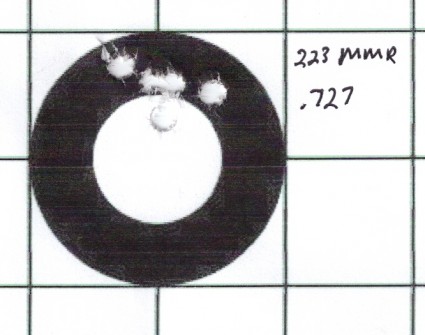 At 100 yards, the best 5 shot group was .727, followed closely by a .814 group. Both came from a load using Hornady’s Z-Max 50 grain bullets on top of Varget powder and sparked by a CCI primer. I also shot a betcha-can’t-do-that-again 10 shot group that measured .618. Unlike many of my range sessions, I’m glad there was photographic evidence of this feat.
At 100 yards, the best 5 shot group was .727, followed closely by a .814 group. Both came from a load using Hornady’s Z-Max 50 grain bullets on top of Varget powder and sparked by a CCI primer. I also shot a betcha-can’t-do-that-again 10 shot group that measured .618. Unlike many of my range sessions, I’m glad there was photographic evidence of this feat.
As an aside, there wasn’t really a bad load for the MMR, but some were clearly better than others. All the factory and handloads grouped in the 1.1 to 1.5 inch range. Again, this is for 5 shot groups, so there was no get-lucky group distorting the data. This isn’t exactly tack-driving territory, but it is certainly adequate for dispatching a variety of varmints and predators at ranges where the .223 would be effective.
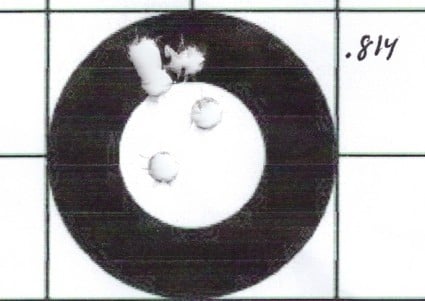 The Nikon P-223 scope is certainly up to the task. The optics are clear even at higher power settings and I find the BDC reticle handy because in a hunting situation, there will often be no time for using the turrets to “dope the scope”. At the higher power settings it is clear the Nikon is made for a price point and the optics are simply not on par with higher end scopes from Germany and Japan. But neither is the price. The Nikon represents excellent value and everything that a hunter would need in a hunting scope.
The Nikon P-223 scope is certainly up to the task. The optics are clear even at higher power settings and I find the BDC reticle handy because in a hunting situation, there will often be no time for using the turrets to “dope the scope”. At the higher power settings it is clear the Nikon is made for a price point and the optics are simply not on par with higher end scopes from Germany and Japan. But neither is the price. The Nikon represents excellent value and everything that a hunter would need in a hunting scope.
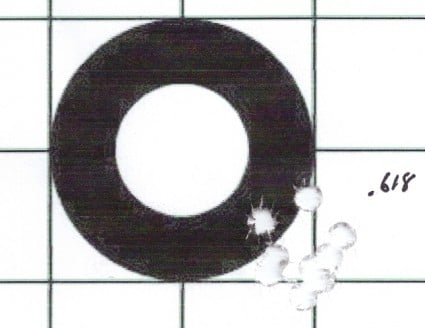 As a hunting rifle, I see the Mossberg being a capable medium range rifle for situations where a quick follow up shot is desirable. Accuracy is certainly good enough to produce clean kills as far out as I’m ever likely to see a brush country coyote.
As a hunting rifle, I see the Mossberg being a capable medium range rifle for situations where a quick follow up shot is desirable. Accuracy is certainly good enough to produce clean kills as far out as I’m ever likely to see a brush country coyote.
For western varmint shooting, the MMR gets a more nuanced rating. Compared to my bolt action .223s, the Mossberg and most other similar-priced ARs, simply don’t perform on the same level. What this means in practical terms is I would certainly pick up the MMR on the occasions where the action was hot, heavy, and close in. For longer range hair splitting where fractions of an inch matter, the tack driving bolt guns are still going to rule the long range roost.
The added dimension is how much fun the AR is to use at the range, it’s simply un-put-downable! That alone, makes it a must keep rifle. Set yourself up some steel spinning targets, invite a few friends, and let ‘er rip. Bring plenty of ammo! It’s amazing how quickly 250 rounds can disappear.
Observations for the Bolt Action Convert
- Battle of the bulge. Real-world ARs are heavy when compared to most sporter-weight bolt action rifles. There are pros and cons to this extra weight, but in general expect to be packing a few extra pounds after your conversion from bolt to AR.
- By necessity. You will probably need to buy AR-specific versions of many accessories you already own for your bolt rifles. AR’s don’t fit most standard gun cases. You’ll need an AR chamber brush, AR-specific cleaning tools and supplies, and so forth. You will also need to evaluate whether other accessories like your benchrest cradle or shooting tripod work with your new AR friend. The magazine well and pistol grip can interfere with some accessories, many of which were designed around a bolt action configuration.
- Back to school. Everything about the AR is different for the first timer who is used to bolt actions. I had to research everything from how to break down the rifle for cleaning to how to extract a stuck cartridge. The information is out there, you just have to be committed to put in a little time in study hall.
- That was awkward. I find the orientation of the charging handle latch awkward for me as a right-handed shooter. I understand the logic behind this configuration, but I’ll be switching over to an ambidextrous charging handle soon.
- Hard pulling. Stock mil-spec triggers with hard pulls are commonplace on the entry-level AR models out there. My complaints about the Mossberg’s trigger seem to be echoed across a range of entry-level models out there. My advice to the bolt action converts? Modify, buy an up-market AR or budget for a replacement trigger. Mil-spec just won’t cut it.
- A big fling. For the reloader, there’s a general pain-in-the-buttski factor of having a rifle fling brass all over God’s green earth. There are a variety of solutions to this and if you want to keep your brass, you’ll be buying one of them soon. Some ranges and gun clubs require users to use a brass catcher.
- Tricks of the trade. After my problem with the live round getting stuck in the chamber, several members of our fine US Armed Forces have told me about the “field fix” for this issue. Open the bolt, remove the magazine, and tap the AR’s buttplate on the ground. The live round should drop out after a few helpful bumps.
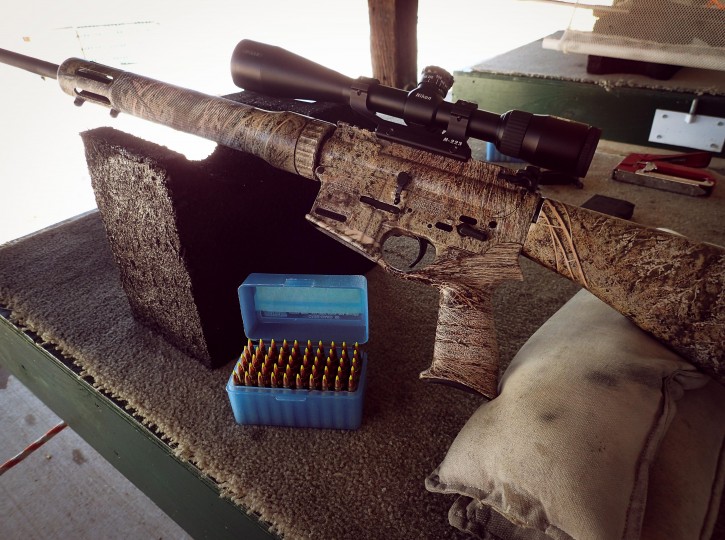
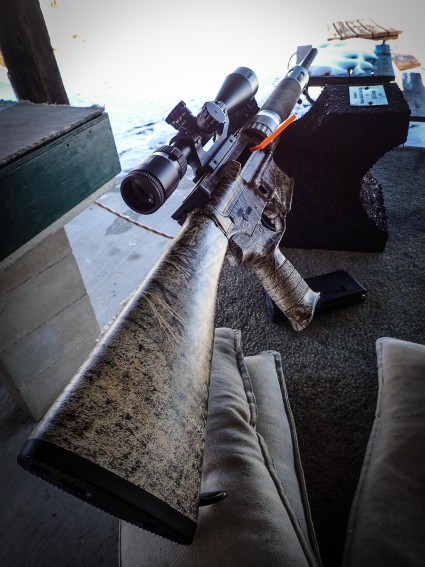
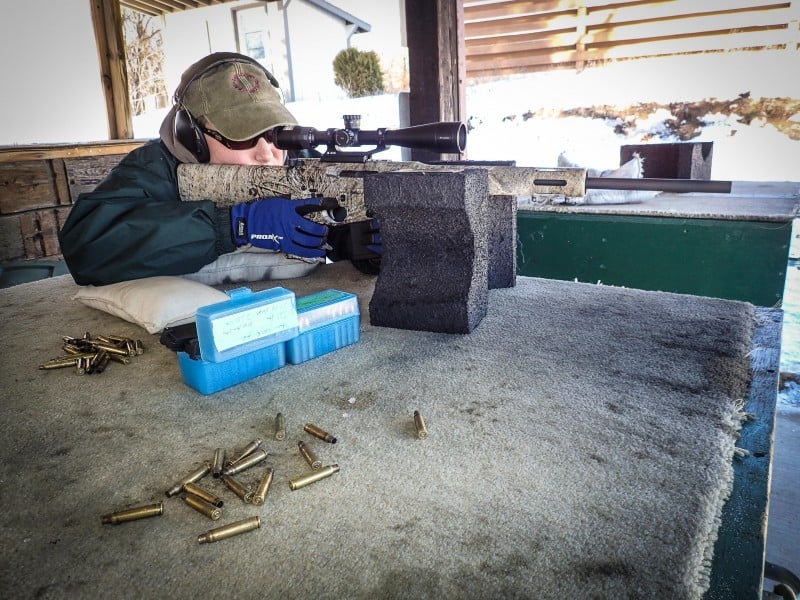
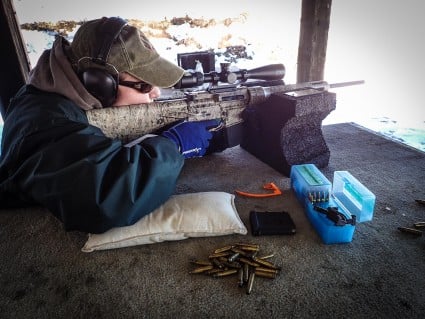
Nice shooting! I shoot the Rock River Predator Pursuit with 50 grain Vmax bullets that I load. I would recommend, also, trying IMR 3031, and a stiff load at that. I used to use Varget with the 50 grainers, but my rifle shot better when I made the switch to 3031. The loads are compressed, but the charge is 24.1 grains and the OAL is 2.250″. Congrats on making the switch! I love mine for dog hunting. Have fun!
Thanks for your comment, Steve.
You’re absolutely right, 3031 is tried and true performer when pushing a .22 caliber bullet. Many consider it a classic powder for the .22-250 and I had an older Savage 12 (now sadly departed due to barrel wear) in .22-250 that this powder was absolute dynamite in, producing ragged hole groups on a basis that would alarm any varmint in the western hemisphere.
I went through a list of the usual smallbore suspects when it came to powder. Varget, 8208 XBR, Benchmark, and 3031, 760, etc. Many of the loadings were very close, so more testing is definitely warranted. I also tested multiple bullet types and weights of 50, 52, 53, and 55 grains.
Overall, in my experience, it’s very difficult to beat the V-Max and Z-Max bullets on top of Varget. It may not be the absolute best, but it will often be a close second if not first.
The AR certainly is a lot of fun. Glad I took the plunge and worked through the transition hiccups.
JMH
Hey Grouse, one of the very best gun reviews I’ve read!
Your observations from a bolt convert mimic my learning about a year ahead of you. 30 years on bolt rifles and pump shotguns will do that. Like you I went and learned on my own. Still not fluent with the charging handle, safety placement, and other items but lack of practice has me to blame. After fishing season my goal is to get more proficient on the platform.
I’ve started doing my own tinkering as well. New buffer spring, grip, and trigger assembly. Maybe the bolt on coffee maker is next.
I set mine up purely for recreational purposes of 100 yards or less. Would be interesting to get glass and a bench to see what it can do. Only a 16″ barrel but the mfr claims sub MOA out of the box.
thanks again
@keeley21 Thanks for your comments on the article.
The charging handle issue is just odd to me, the idea of it being set up a right handed person to work the charging handle with the left hand just didn’t work for me. Fortunately, there are lots of people who agree and therefore lots of aftermarket charging handles available to fix this.
There are an ever-increasing number of good ARs out there and the accuracy potential is there for sub MOA and better. However, it does still require work–probably more work than the vast majority of bolt guns currently on the market. I have a Savage Axis in .223 that will shoot circles around the MMM, and for the cost of the MMR, I could have bought almost 3 of the Axis.
I’m going to be getting some range time at 200 and 300 soon, so it will be interesting to see where the performance ends up at longer ranges.
Thanks again.
Jay